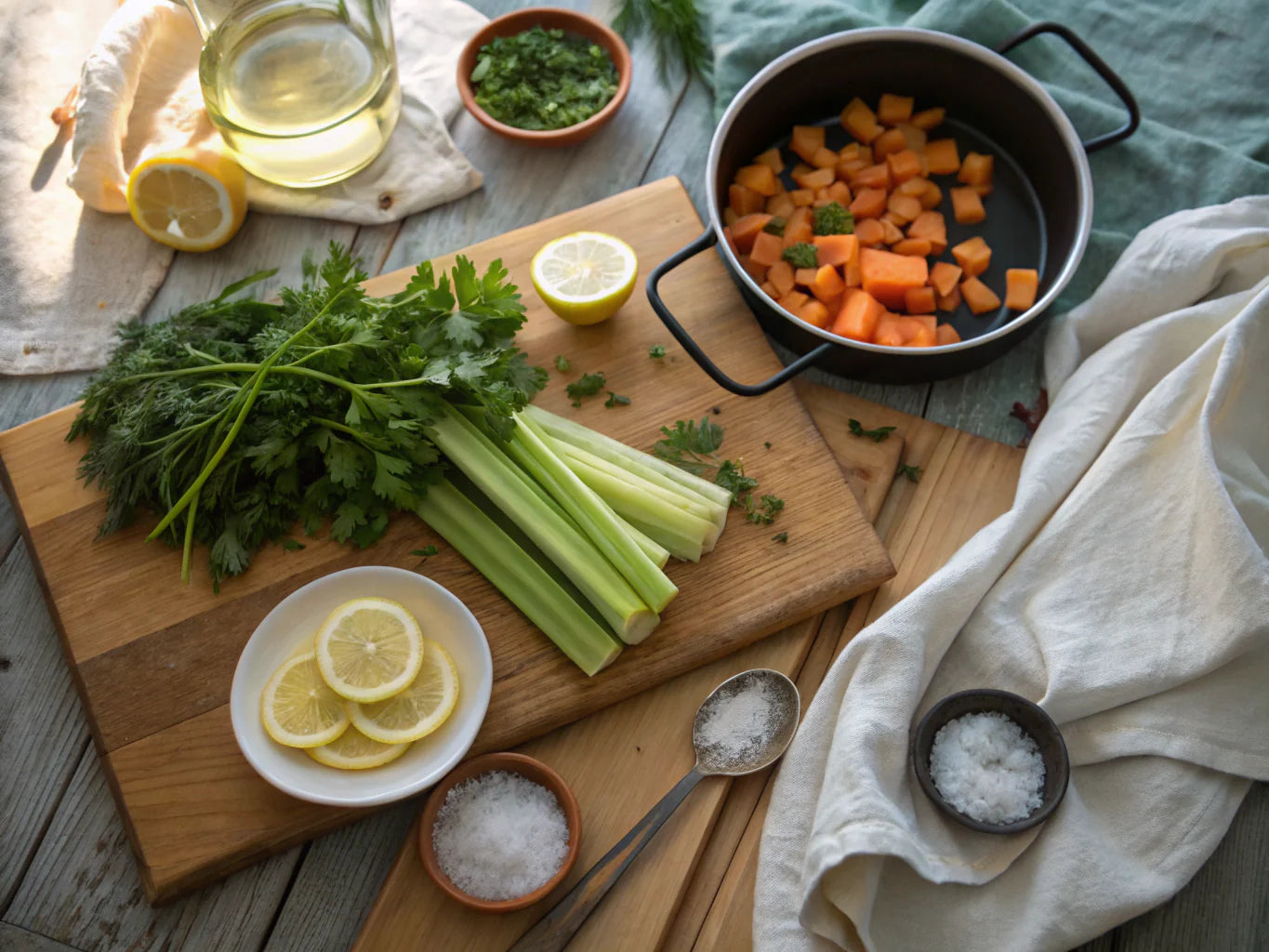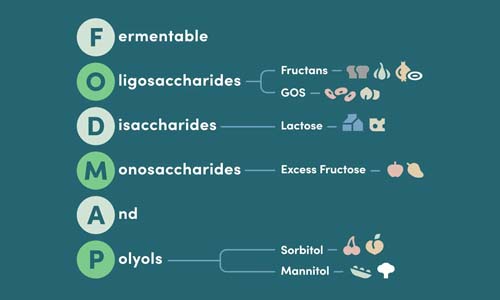Healthy Vegetable Broth for Cooking Soups: The Guide

Key Takeaways
- This guide is designed for both beginners and experienced cooks interested in healthy vegetable broth.
- It focuses on selecting clean ingredients for making nutritious vegetable broth.
- The guide aims to help maximize both the flavor and digestive benefits of vegetable broth.
- It emphasizes the importance of homemade broth for cooking soups.
Table of Contents
- The Modern Gourmet Guide to Healthy Vegetable Broth
- What Is Healthy Vegetable Broth?
- The Nutritional and Practical Benefits of Vegetable Broth
- Ingredient Selection: The Foundation of Healthy, Flavorful Broth
- Best Healthy Vegetable Broths for Cooking Soups
- Detailed Comparison: Key Features
- Homemade vs. Store-Bought: Making the Right Choice
- Choosing the Best Store-Bought Vegetable Broth
- Creative Ways to Use Vegetable Broth Beyond Soup
- Troubleshooting Common Broth Issues
- The Low FODMAP Advantage for Digestive Health
The Modern Gourmet Guide to Healthy Vegetable Broth
Welcome, home cooks, gut-health explorers, and flavor seekers! Whether you're crafting your first pot of homemade soup or you're a seasoned chef looking to elevate your broth game, you've landed in the right place. We're here to guide you through everything you need to know about healthy vegetable broth for cooking soups, from selecting the cleanest ingredients to maximizing both taste and digestive comfort.
At Gourmend Foods, we believe that exceptional broth is the foundation of culinary creativity and gut-friendly comfort. It's the secret ingredient that transforms ordinary ingredients into extraordinary meals, all while keeping your digestion happy and your taste buds singing.
Here's the thing: the right vegetable broth doesn't just add liquid to your soup, it creates a canvas for gourmet flavors without the digestive drama that comes with conventional broths loaded with high-FODMAP ingredients.
What Is Healthy Vegetable Broth?

Vegetable broth is a lightly simmered, plant-based liquid that captures the essence of vegetables, herbs, and aromatics through gentle cooking. It's distinct from vegetable stock, which tends to be more concentrated and less seasoned, and completely different from bone broth, which derives its richness from animal bones through extended simmering.
Important distinction: At Gourmend, our Chicken and Beef products are actually bone broths, rich, collagen-packed liquids that undergo longer cooking processes. Our Vegetable option delivers pure plant-based flavor with the same artisanal quality.
In the kitchen, healthy vegetable broth serves as the essential base for soups, risottos, sauces, and even sipping broths. What makes it "healthy" goes beyond just being plant-based, it's about choosing clean-label options that support your digestive wellness while delivering restaurant-quality flavor.
A truly exceptional vegetable broth offers subtle depth and umami richness without overpowering salt or digestive irritants. It should enhance your soup's natural flavors, not mask them, creating a harmonious foundation that lets your other ingredients shine.
The Nutritional and Practical Benefits of Vegetable Broth
Key Nutrients and Wellness Highlights
Quality vegetable broth delivers a concentrated dose of vitamins A, C, and K, along with essential minerals like potassium and magnesium. These nutrients leach from the vegetables during the simmering process, creating a nourishing liquid that's both hydrating and low in calories.
For those managing digestive sensitivities, the right vegetable broth offers gut-friendly comfort through easier digestion and reduced bloating compared to conventional broths. This is especially true when the broth avoids high-FODMAP ingredients that can trigger discomfort in sensitive individuals.
Broth in a Plant-Forward Diet
Vegetable broth stands as a champion for vegetarians, vegans, gluten-sensitive cooks, and anyone embracing flexitarian meals. It provides the savory depth traditionally associated with meat-based broths while keeping your meals completely plant-centered.
Pros
- Rich in plant-based nutrients and antioxidants
- Naturally low in calories and fat
- Supports hydration and digestive comfort
- Versatile base for countless recipes
Cons
- Lower protein content than bone broths
- Requires careful ingredient selection for optimal flavor
- Homemade versions need time investment
Homemade vs. Store-Bought: The Reality Check
While homemade broth offers complete control over ingredients and sodium levels, the time investment can be substantial. Quality store-bought options can deliver exceptional results when chosen carefully, and this is where Gourmend shelf-stable broth cartons shine as the gold standard.
Most conventional boxed broths sneak in high-FODMAP additives like onion powder, garlic, and artificial flavors that can trigger digestive discomfort. Our approach uses only chive sprigs, scallion greens, and leek tops to achieve that coveted onion-garlic satisfaction without the bloating or heaviness.
Ingredient Selection: The Foundation of Healthy, Flavorful Broth

Best Vegetables for Broth (Low FODMAP-Focused)
The secret to exceptional vegetable broth lies in selecting ingredients that deliver maximum flavor while supporting digestive wellness. Our top picks include carrots for natural sweetness, parsnips for earthy depth, and the green tops of leeks and scallions for that essential aromatic foundation.
- Carrots and Parsnips: Natural sweetness and body
- Leek Greens and Scallion Tops: Onion-like depth without FODMAP concerns
- Celery and Tomatoes: Classic aromatic base and umami richness
- Chive Sprigs: Gentle onion flavor that's gut-friendly
- Mushrooms (Oyster and Shiitake): Powerful umami boosters
- Nori Seaweed: Ocean-derived depth and minerals
Pro Tip: Limit your base flavors to three unique ingredients for the cleanest, most layered taste. This approach prevents muddied flavors while ensuring each element contributes meaningfully to the final broth.
Herbs, Spices, and Natural Flavor Promoters
Fresh herbs transform good broth into great broth. Parsley stems (save the leaves for garnish), thyme sprigs, and bay leaves provide classic French depth, while basil and oregano offer Mediterranean warmth. For global inspiration, consider fresh ginger and turmeric for anti-inflammatory benefits, or mild chili flakes for gentle heat.
The umami enhancers make all the difference: a strip of nori seaweed, a handful of oyster mushrooms, or a piece of kombu (removed before serving) can elevate your broth from simple to sublime. These ingredients provide the savory depth typically associated with meat-based broths.
"Fat matters in broth-making. Sautéing your aromatics in quality olive oil or a touch of ghee before adding water unlocks rich, rounded flavors that water alone cannot extract."
Vegetables and Add-Ins to Avoid
For truly healthy, digestive-friendly broth, avoid high-FODMAP vegetables such as onion bulbs, shallots, and garlic. Instead, opt for chive sprigs, green leek tops, and scallion greens to achieve that classic aromatic base without digestive discomfort. This substitution ensures your broth remains gentle and flavorful, supporting both taste and gut wellness.
Best Healthy Vegetable Broths for Cooking Soups
When selecting healthy vegetable broth for cooking soups, the foundation of exceptional flavor starts with clean ingredients and thoughtful preparation. We've tested and compared the top options available to home cooks who want both gourmet results and digestive peace of mind.
Gourmend Foods Vegetable Broth - Best Overall
Best for: IBS-friendly cooking, gourmet soup bases, clean-label enthusiasts
Rating: 5/5 stars
Gourmend Foods delivers what we consider the gold standard in healthy vegetable broth for cooking soups. This isn't your typical boxed broth, it's crafted with low FODMAP principles that make it gentle on sensitive digestive systems while never compromising on depth of flavor.
What sets Gourmend apart is the intelligent ingredient selection. Instead of harsh onion bulbs that trigger digestive discomfort, we use chive sprigs and scallion greens for that essential aromatic base. The addition of nori seaweed and oyster mushrooms creates remarkable umami depth that transforms any soup into a restaurant-quality experience.
Pros
- Low FODMAP certified for easier digestion
- Clean label with no artificial additives
- Rich umami flavor from nori and mushrooms
- Shelf-stable convenience with homemade quality
Cons
- Premium pricing compared to conventional options
- May require adjustment for those accustomed to high-sodium broths
Pacific Foods Organic Vegetable Broth
Best for: Organic-focused cooking, widely available option
Rating: 3/5 stars
Pacific Foods offers an organic vegetable broth that's readily available in most grocery stores. While it provides decent flavor for everyday cooking, it contains onion powder and garlic powder that can trigger digestive issues for sensitive individuals. The organic certification appeals to clean-eating enthusiasts, but the flavor profile tends toward the salty side without the complex depth that makes soups truly memorable.
Swanson Vegetable Broth - Budget-Friendly
Best for: Budget-conscious cooking, basic soup recipes
Rating: 2/5 stars
Swanson provides an affordable vegetable broth option that works for basic soup preparation. However, the ingredient list includes several additives and flavor enhancers that don't align with clean-label priorities. The taste is notably thin compared to premium options, often requiring additional seasoning to achieve satisfactory depth in finished soups.
Imagine Organic Low-Sodium Vegetable Broth
Best for: Sodium-conscious cooking, organic preference
Rating: 3/5 stars
Imagine's low-sodium organic broth appeals to those monitoring salt intake while maintaining organic standards. The reduced sodium allows for better control over seasoning in your finished soup. However, like many conventional broths, it relies on onion and garlic for flavor, making it unsuitable for low FODMAP diets or those with digestive sensitivities.
Detailed Comparison: Key Features

Understanding the differences between healthy vegetable broth options helps you make the best choice for your cooking style and dietary needs. This comprehensive comparison examines the most important factors that impact both flavor and digestive comfort.
| Brand | FODMAP Status | Organic | Sodium (per cup) | Key Ingredients | Price Range | Availability |
|---|---|---|---|---|---|---|
| Gourmend Foods | Low FODMAP | Yes | Moderate | Chive sprigs, nori, oyster mushrooms | Premium | Online, select stores |
| Pacific Foods | High FODMAP | Yes | High | Onion powder, garlic powder | Mid-range | Widely available |
| Swanson | High FODMAP | No | High | Natural flavors, additives | Budget | Widely available |
| Imagine | High FODMAP | Yes | Low | Onion, garlic | Mid-range | Widely available |
Homemade vs. Store-Bought: Making the Right Choice
The decision between crafting your own healthy vegetable broth or selecting a premium store-bought option depends on your priorities, time constraints, and cooking goals. Both approaches offer distinct advantages for creating exceptional soups.
The Homemade Advantage
Creating vegetable broth from scratch gives you complete control over ingredients and flavor intensity. You can customize the vegetable selection based on seasonal availability and personal taste preferences. For those following low FODMAP guidelines, homemade broth ensures you're using only chive sprigs, leek greens, and other digestive-friendly ingredients.
The process itself can be meditative and rewarding. Sautéing carrots, parsnips, and chive sprigs in olive oil before simmering creates layers of flavor that develop beautifully over 45-60 minutes. Adding nori seaweed and oyster mushrooms during the simmer provides that essential umami depth that makes soups truly satisfying.
Time Investment: Homemade broth requires 60-90 minutes of active and passive cooking time, plus cooling and straining.
Premium Store-Bought Convenience
High-quality shelf-stable broth like Gourmend's vegetable broth offers the convenience of homemade flavor without the time investment. This becomes invaluable for busy weeknight cooking when you want gourmet results in minimal time.
The consistency of premium store-bought options also means you can rely on consistent flavor profiles every time you cook. Whether you're making a quick weeknight soup or preparing for a dinner party, knowing your broth will deliver the same depth and quality removes guesswork from the equation.
For more inspiration on how to use healthy vegetable broth for cooking soups and other dishes, check out our collection of low FODMAP recipes that showcase creative, gut-friendly meals.
Choosing the Best Store-Bought Vegetable Broth
Choosing the right store-bought vegetable broth can make all the difference in your cooking. Look for options with clean labels, minimal additives, and ingredients that align with your dietary needs. For those seeking low FODMAP and gourmet flavor, Gourmend Foods Vegetable Broth stands out for its careful ingredient selection and chef-level flavor development.
Gourmend Foods Vegetable Broth - Best Overall
Best for: Low FODMAP cooking, sensitive digestions, and gourmet flavor without compromise
Rating: 5/5 stars
Gourmend Foods sets the gold standard for healthy vegetable broth for cooking soups. What makes our vegetable broth exceptional is the careful selection of low FODMAP ingredients combined with chef-level flavor development. We use chive sprigs, scallion greens, and leek tops to deliver that satisfying onion-like depth without the digestive discomfort that comes from traditional onion and garlic.
The secret to our broth's remarkable umami lies in the addition of nori seaweed and oyster mushrooms, ingredients that create layers of savory complexity typically missing from plant-based broths. This isn't just vegetable water; it's a foundation that transforms simple ingredients into restaurant-quality soups.
Pros
- Certified low FODMAP for sensitive digestions
- Clean label with no artificial additives
- Rich umami from nori and mushrooms
- Shelf-stable convenience with homemade taste
Cons
- Premium pricing reflects quality ingredients
- May require specialty ordering online
Pacific Foods Organic Vegetable Broth
Best for: Organic-focused cooks seeking wide availability
Rating: 3/5 stars
Pacific Foods offers an organic option that's widely available in most grocery stores. Their vegetable broth provides a clean, mild flavor that works well as a neutral base for soups where you want other ingredients to shine.
However, this broth contains high FODMAP ingredients like onions and garlic, making it unsuitable for those following a low FODMAP diet or managing IBS symptoms.
Swanson Vegetable Broth
Best for: Budget-conscious cooking and basic soup needs
Rating: 2/5 stars
Swanson provides an economical vegetable broth option that's readily available and affordable. The flavor profile is straightforward and mild, making it suitable for simple soup recipes where cost is the primary consideration.
The downside is a relatively thin consistency and limited flavor complexity. Like most conventional broths, it also contains high FODMAP ingredients that can trigger digestive issues.
Creative Ways to Use Vegetable Broth Beyond Soup
While soup might be the obvious application, healthy vegetable broth for cooking soups extends far beyond the soup pot. Understanding these versatile applications helps you maximize both flavor and nutritional value across your entire cooking repertoire.
Cooking Grains and Legumes
Replace water with vegetable broth when cooking quinoa, rice, or oats for an instant flavor upgrade. The broth infuses each grain with savory depth that transforms simple sides into memorable dishes. For low FODMAP cooking, stick to appropriate serving sizes, lentils should be limited to less than ⅓ cup cooked per serving to maintain digestive comfort.
Deglazing and Sauce Building
After sautéing vegetables or proteins, deglaze your pan with a splash of vegetable broth to capture all those flavorful browned bits. This technique creates the foundation for rich, restaurant-quality sauces without heavy cream or butter. The clean flavor profile of quality broth lets you build complexity without overwhelming delicate ingredients.
Steaming and Braising
Use vegetable broth instead of water when steaming vegetables or braising proteins. This gentle cooking method infuses subtle flavor throughout the ingredients while maintaining their natural textures. The result is more sophisticated side dishes that complement rather than compete with your main course.
For more ways to enhance your meals, explore our learn section for tips and techniques on maximizing flavor and nutrition in every dish.
Troubleshooting Common Broth Issues
Even experienced cooks encounter challenges when working with vegetable broth. Understanding how to identify and fix these issues ensures consistently excellent results in your soup-making endeavors.
Fixing Bland or Weak Broth
If your broth tastes flat or watery, the solution often lies in concentration and seasoning. Simmer uncovered to reduce the liquid and concentrate flavors. Add salt gradually, tasting as you go, proper seasoning can transform mediocre broth into liquid gold.
Remember that broth should taste slightly over-seasoned on its own, as it will dilute when combined with other soup ingredients.
Preventing Cloudy Broth
Cloudy broth results from vigorous boiling, which breaks down vegetables and creates an unappealing appearance. Maintain a gentle simmer throughout the cooking process, and strain through fine-mesh sieves or cheesecloth for crystal-clear results.
Balancing Oversalted Broth
If you've added too much salt, don't panic. Add a peeled potato chunk to absorb excess sodium, or dilute with additional water and re-season with fresh herbs and a squeeze of lemon juice to restore balance.
For additional troubleshooting tips and the science behind broth nutrition, see this Harvard Health resource for expert-backed advice on making your soups healthier.
The Low FODMAP Advantage for Digestive Health
Understanding the science behind low FODMAP cooking transforms how you approach healthy vegetable broth for cooking soups. This isn't about restriction, it's about creating abundant, flavorful meals that support digestive wellness.
What Low FODMAP Means for Your Kitchen
FODMAPs are fermentable carbohydrates that can trigger digestive discomfort in sensitive individuals. By choosing ingredients like chive sprigs instead of onions and green leek tops instead of shallots, you maintain the aromatic complexity that makes soup satisfying while avoiding ingredients that cause bloating or digestive upset.
The beauty of this approach is that it benefits everyone, not just those managing IBS. Easier digestion means more energy for enjoying your meal and your day.
Flavor Without Compromise
Gourmend's approach to vegetable broth formulation is supported by emerging research on the benefits of low FODMAP diets for digestive health.





